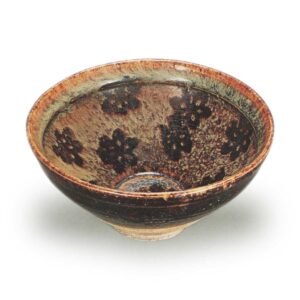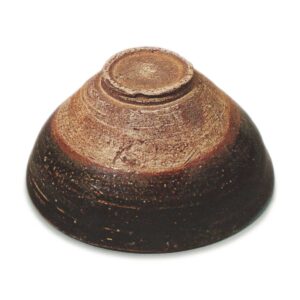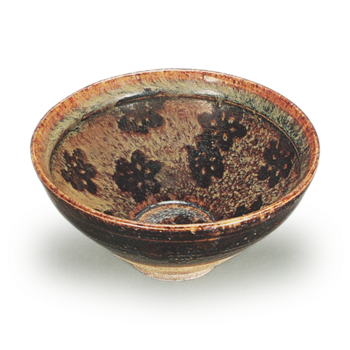

Height: 5.7 to 6.0 cm
Diameter: 11.6 to 11.9 cm
Outer diameter of foot ring: 4.2 to 4.3 cm
Height of foot ring: 0.6 cm
The Baika Tenmoku bowl is a type of Taipa bowl, and like the Monji Tenmoku, Mokuhyo Tenmoku, Ran Tenmoku and Ryu Tenmoku bowls, it was made at the Ji Zhou kilns in Jiangxi province during the Southern Song dynasty.
The Ji Zhou kilns were located in Yonghe Town (Yonghe Lu), about 6km south of Ji’an County, which is about 130km south of Nanchang, the capital of Jiangxi Province, and were a major center for pottery production in South China.
The origins of the Ji Zhou kilns are said to date back to the Tang Dynasty, and some say even earlier. From the ruins of the Jizhou kilns, fragments of celadon and blue-and-white porcelain from the Tang dynasty have been discovered, and the world-famous blue-and-white porcelain phoenix-head vase in the British Museum is considered to be a masterpiece representative of the Jizhou kilns. During the Northern Song dynasty, they produced tenmoku and white porcelain, and during the Southern Song dynasty, they mainly produced celadon and tenmoku, and during the Ming dynasty, they produced white porcelain and underglaze blue-and-white porcelain. However, according to the book “Jizhou Kiln” by Jiang Xianbo, the most common type of pottery found at the kiln site is tenmoku shards, and the Jizhou kiln is said to have produced mainly tenmoku, just like the Jian kiln. It is said that when the Ming Dynasty came to an end, tenmoku fell out of fashion and the kiln was abandoned, and many of the potters moved to Jingdezhen.
The Yixiu tenmoku is commonly known in Japan as “taihagai”. Unlike the Jian ware, it is a kiln with excellent techniques, and it uses a variety of techniques to make tenmoku, but it is particularly good at making glazes that look just like tortoiseshell, so it is called “taihagai” or “taihagai”.
Taihada is also written as taihada, taiki-da, nouki-da, and ame-ki-da, and is also called taikada and kikkou-da. The most famous bowl of this type is a tea bowl (National Treasure) with a floral pattern on the inside that was passed down in the Matsudaira family of Unshu, and the best example of Mokuhyo Tenmoku is a tea bowl (Important Cultural Property) that was passed down in the Maeda family. , which is also a national treasure, has a glaze that is exactly like a tortoiseshell, and like the Kenzan tea bowl, there are no other countries in the world that have as many masterpieces as Japan. The inside is also one of the outstanding pieces in the Taihō collection, and it is a small work that is both austere and tasteful, and which we should all love.
The clay is a rough, pale eggshell-colored clay, and this is covered in a dull black glaze all over, and then a double-glaze of a non-vitreous glaze mixed with straw ash is applied to the inside only. The black black plum blossom pattern is made by cutting paper with a metal clamp to create a flower pattern, which is called katagami in Japan and called sian in China, and then attaching it to the inside of the tea bowl, which has been covered in black glaze on the inside and outside, as shown in the diagram. , a double layer of non-transparent glaze is applied, and when the stencil is gently removed after it has dried, the inside of the bowl has a double layer of glaze, but only the black glaze on the patterned part is applied, so when it is fired, it turns black, and the other parts have a double layer of glaze, so it has a glaze tone like a tortoiseshell.
Outside



